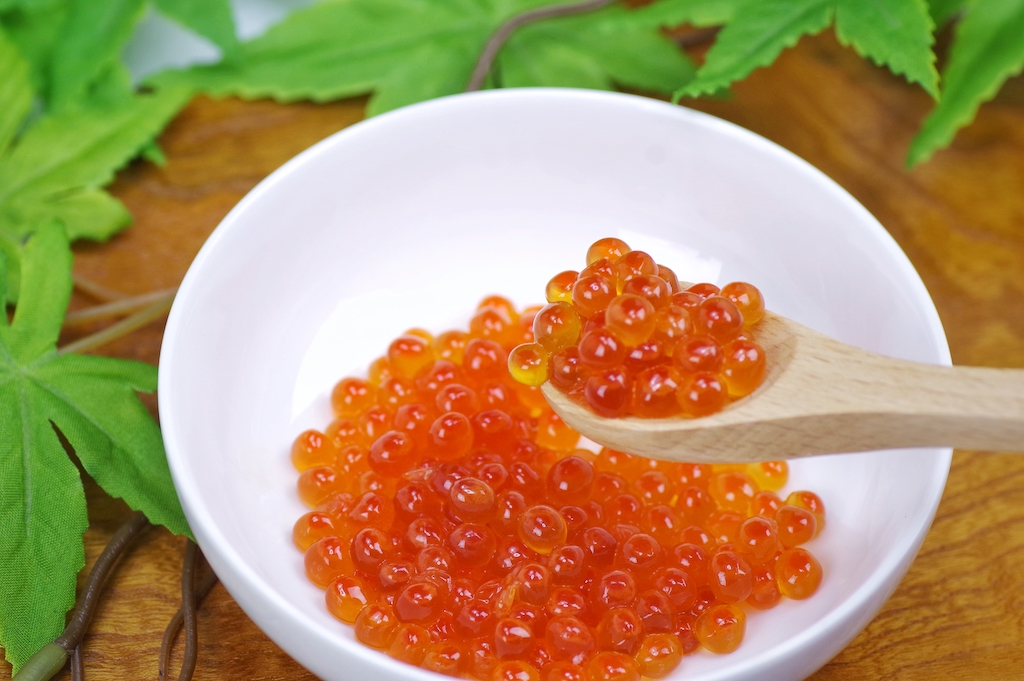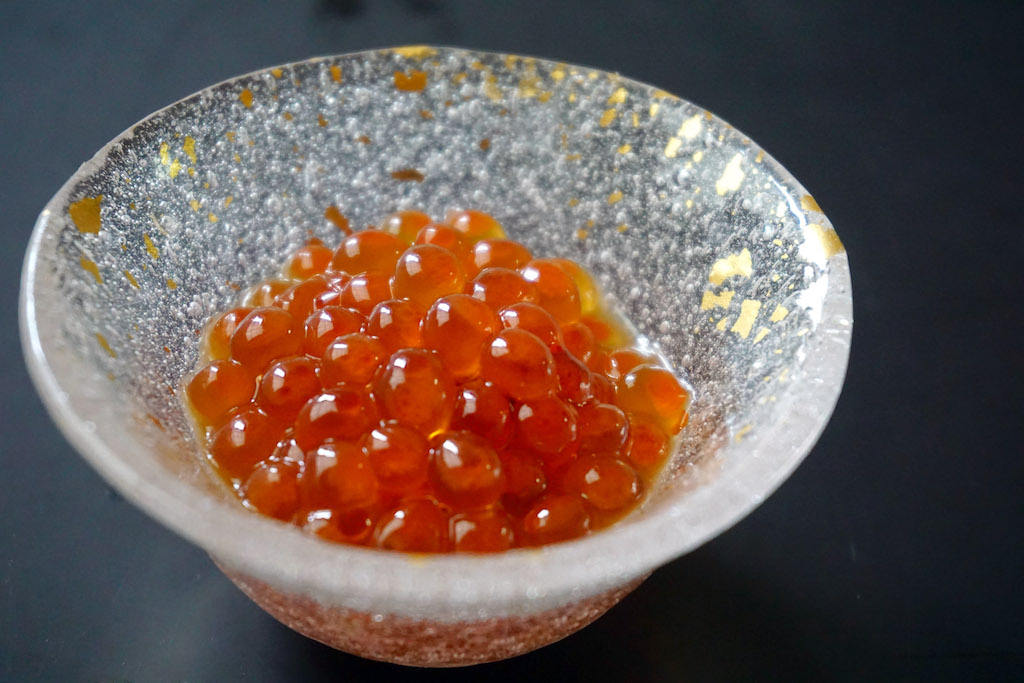Ever tasted a burst of the ocean, a pop of flavor that dances on your tongue? That, my friend, is the magic of Ikura, the exquisite cured salmon roe that has captivated palates worldwide.
Ikura, with its vibrant orange hue and delicate, translucent eggs, is more than just a sushi topping; it's a culinary experience. This article will delve into the fascinating world of Ikura, exploring its origins, cultural significance, culinary applications, and even its linguistic roots. Prepare to be immersed in the details of this beloved ingredient, from its preparation to its place in the Japanese culinary landscape, and beyond.
The journey of Ikura is a relatively modern one, a testament to the evolving nature of Japanese cuisine. While the traditions of sushi and seafood preparation run deep, Ikura's prominence is a relatively recent phenomenon. Originating in the latter half of the 20th century, its popularity has skyrocketed, transforming from a regional delicacy to a global gourmet staple. Its appeal lies not just in its taste, but also in its texture, a unique sensation that sets it apart. Each bite releases a burst of briny, umami-rich flavor, making it an unforgettable culinary experience.
- Directv Channel Guide Amc Shows Listings More Watch Now
- Brooke Monk Nudes More Uncensored Content Updates
Let's start with the basics: what exactly is Ikura? The Japanese word, derived from Russian "ikra" meaning "fish eggs," specifically refers to salmon roe. These aren't just any fish eggs; they are large, plump, and of the highest quality, often sourced from wild-caught salmon. The characteristic orange color is a signal of their freshness and quality, a vibrant hue that enhances their visual appeal.
| Name | Ikura () |
| Pronunciation | ee-koo-rah |
| Meaning | Salmon Roe, "Roe of Salmon" |
| Origin | Japan (popularized in the late 20th century) |
| Main Use | Sushi topping, ingredient in various Japanese and Western dishes |
| Flavor Profile | Briny, salty, umami-rich, with a slightly sweet undertone |
| Texture | Juicy, pops with every bite |
| Cultural Significance | A symbol of luxury and celebration, often served during special occasions |
| Popular Dishes | Ikura sushi (gunkan maki), Ikura donburi, Pasta with Ikura |
| Where to Buy | Specialty seafood stores, Japanese grocery stores, online retailers |
| Reference Website | Just One Cookbook - Ikura |
The preparation of Ikura is a meticulous process, crucial in ensuring the quality and preserving the delicate flavor of the roe. The process begins with the careful extraction of the salmon eggs. This is typically done during the late summer and fall, when the fish are at their peak. After extraction, the roe is gently separated from the membrane and then meticulously cleaned. The next stage involves brining, where the eggs are typically soaked in a salt solution, sometimes with the addition of soy sauce or other seasonings. This process serves multiple purposes: it enhances the flavor, preserves the roe, and firms up the texture. Finally, the Ikura is often frozen at very low temperatures to ensure its long-term preservation and maintain its freshness.
The flavor nuances of Ikura are complex and captivating. The initial burst of saltiness is quickly followed by an explosion of umami, a savory, almost meaty flavor that lingers on the palate. There's a hint of sweetness, a subtle complexity that elevates the overall experience. The texture is equally important: each egg is firm yet yielding, popping with a satisfying burst when bitten. This combination of flavor and texture is what makes Ikura such a sought-after delicacy.
- Dan Souzas Strawberry Refrigerator Jam Recipe More
- Marty Deeks On Ncis La Everything You Need To Know
Beyond its culinary appeal, Ikura holds a significant place in Japanese culture. It is often considered a symbol of luxury and is frequently served during special occasions and celebrations. The vibrant color and the unique flavor profile add a touch of elegance to any meal. In many Japanese restaurants, Ikura is featured as a prominent element on the menu, either as a topping for sushi or as part of elaborate dishes.
Ikura is remarkably versatile in the kitchen, finding its way into a wide variety of dishes. One of the most popular is Ikura sushi, especially gunkan maki, where the roe is nestled atop a bed of sushi rice, bound by a strip of nori seaweed. This presentation perfectly showcases the glistening orange eggs, inviting diners to experience the full flavor profile.
Beyond sushi, Ikura is a star ingredient in Ikura donburi, a rice bowl topped generously with the glistening roe. The simplicity of the dish allows the flavor of the Ikura to shine, perfectly complementing the rice. It can also be incorporated into pasta dishes, adding a luxurious touch to creamy sauces, or as a garnish for salads and other culinary creations. Chefs around the world are experimenting with Ikura, finding innovative ways to utilize its unique flavor and texture in both traditional and contemporary cuisine.
Now, let's address the linguistic aspect: "Ikura" (\u3044\u304f\u3089) in Japanese. It's primarily used to ask "how much?" The Japanese language, known for its context-dependent nature, assigns multiple meanings to the word. Ikura can be used in stores, restaurants, and markets, whenever you're inquiring about the price of an item.
For example, the phrase "[ikura desu ka] (\u5024\u6bb5\u3092\u805e\u304f\u3068\u304d\u306b\u4f7f\u3044\u307e\u3059\u3002) how much is it?" is used to inquire about the price of any item. It's a practical and essential phrase for navigating everyday life in Japan. While the primary focus is on "how much," Ikura can sometimes be used to mean "how many," depending on the context.
The phrase "\u3044\u304f\u3089 \u4f55 (\u306a\u3093) \u3067\u3082 (ikura nandemo)" translates to "as many as one likes" or "whatever amount." This versatility underscores the importance of the word in the Japanese language, extending beyond its simple role as a cost inquiry.
The world of fish roe can be a complex one, with several varieties often confused. While Ikura exclusively refers to salmon roe, other types of roe, like Tobiko (flying fish roe) and Masago (capelin roe) are often used in similar dishes. Each type has its unique characteristics, from size and texture to flavor. Tobiko, for example, is smaller and has a slightly crunchy texture, often used in sushi rolls for visual appeal. Masago, on the other hand, is smaller still and often dyed, providing colorful accents to dishes. These differences highlight the importance of understanding the specific type of roe used in any given recipe.
The popularity of Ikura has, in some ways, affected the fish supply chain. The demand for fresh roe has led to a mixed effect on the industry. With the possibility of an overall reduction in the supply of marinated Ikura, the biggest problem for the makers is the retailer marketing strategy.
In addition to its extraordinary taste, Ikura provides certain health benefits. Ikura is also one of the healthier ingredients you can enjoy. Salmon roe is sourced in the late summer and fall from fish that are still in the ocean. It is a good source of omega-3 fatty acids, which are beneficial for heart health and brain function. It also contains vitamins and minerals, contributing to a well-balanced diet.
The use of "Ikura" (\u3044\u304f\u3089) is also a great way to practice your Japanese language skills. Every example sentence includes a Japanese furigana reading, the romaji reading, and the English translation.
Ikura is more than just a taste test; it's a journey. Its taste, the way its produced, the different varieties, and the comparison to other types of fish roe all contribute to the fascination with this ingredient.
From the simple elegance of Ikura sushi to the more adventurous creations in modern cuisine, Ikura continues to captivate the world. Whether you are a seasoned sushi connoisseur or a curious newcomer, the allure of Ikura is undeniable. So, the next time you have the chance, savor a spoonful of this culinary treasure, and experience for yourself the burst of the ocean that is Ikura.



Detail Author:
- Name : Mr. Deonte Renner
- Username : maximo62
- Email : green.maximus@gmail.com
- Birthdate : 1971-06-06
- Address : 315 Solon Green Gilbertburgh, KS 75765-4940
- Phone : 1-650-538-9280
- Company : Collier Inc
- Job : Food Scientists and Technologist
- Bio : Ut blanditiis dignissimos ad pariatur. Amet autem quia aliquid. Qui omnis quaerat ut.
Socials
linkedin:
- url : https://linkedin.com/in/cara.batz
- username : cara.batz
- bio : Et fugiat voluptas quod magnam dolor fugit.
- followers : 5426
- following : 2625
facebook:
- url : https://facebook.com/cara_id
- username : cara_id
- bio : Nesciunt id eum omnis quasi. Provident at est aperiam.
- followers : 4076
- following : 1866
twitter:
- url : https://twitter.com/cara_batz
- username : cara_batz
- bio : Et autem amet iste dolorem autem dolore. Aut nobis aut voluptatem quia corporis suscipit vitae nihil. Ea explicabo nobis itaque. Qui modi ea aut amet aut.
- followers : 3415
- following : 994